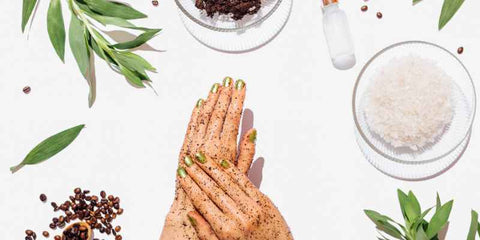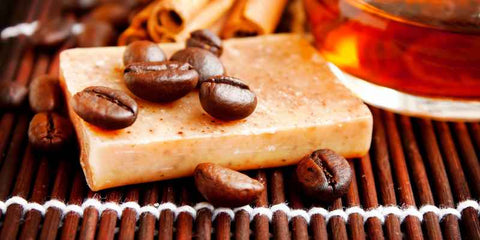
Are you tired of dealing with stubborn acne and blemishes that just won't go away? Look no further - the secret to achieving clear, radiant skin may lie in a simple bar of soap. Exfoliating soap, to be precise. Exfoliation is a crucial step in any skincare routine, as it helps to slough off dead skin cells, unclog pores, and keep acne-causing bacteria at bay. By incorporating an exfoliating soap into your daily regimen, you can effectively combat acne and blemishes, revealing a smoother and more even complexion. But what makes exfoliating soap so effective? Well, it's all in the ingredients. These soaps typically contain gentle exfoliants like oatmeal, jojoba beads, or fruit enzymes that work to remove impurities without stripping the skin of its natural oils. So, if you're ready to bid farewell to acne and hello to clear, glowing skin, it's time to give exfoliating soap a try.

The importance of exfoliation for clear skin
Exfoliation is a vital step in achieving and maintaining clear skin. Our skin naturally sheds dead skin cells, but sometimes this process can become sluggish, leading to a build-up of dead skin cells on the skin's surface. This build-up can clog pores, causing acne and blemishes. Regular exfoliation helps to remove these dead skin cells, unclog pores, and promote cell turnover, revealing fresh, healthy skin underneath. It also allows skincare products to penetrate deeper into the skin, making them more effective. By incorporating exfoliating soap into your skincare routine, you can enhance the exfoliation process and achieve clearer, smoother skin.
There are two types of exfoliation: physical and chemical. Physical exfoliation involves using scrubs or tools to physically slough off dead skin cells, while chemical exfoliation involves using acids or enzymes to dissolve the bonds that hold dead skin cells together. Exfoliating soap falls under the category of physical exfoliation, as it contains gentle exfoliants that help to remove dead skin cells and impurities. The abrasive texture of these soaps helps to manually exfoliate the skin, resulting in a smoother and more even complexion.
Exfoliating soap is particularly beneficial for those with acne-prone or oily skin. Acne is often caused by the overproduction of oil, which can clog pores and lead to breakouts. By regularly using exfoliating soap, you can effectively remove excess oil, dirt, and bacteria from the skin's surface, reducing the likelihood of acne formation. Additionally, exfoliating soap helps to unclog pores, preventing them from becoming blocked and inflamed. By keeping the skin clean and clear, exfoliating soap can significantly improve the appearance of acne and blemishes.
Understanding acne and blemishes
Before we delve deeper into how exfoliating soap can help combat acne and blemishes, let's first understand the causes behind these common skin concerns. Acne is a skin condition characterized by the presence of pimples, blackheads, whiteheads, and cysts. It occurs when hair follicles become clogged with oil, dead skin cells, and bacteria. Hormonal changes, excess oil production, certain medications, and genetic factors can all contribute to the development of acne. Blemishes, on the other hand, refer to any type of discoloration or mark on the skin, including acne scars, dark spots, and hyperpigmentation.
Acne and blemishes can have a significant impact on one's self-esteem and overall well-being. They often make us feel self-conscious and can be challenging to treat. While there are numerous skincare products available on the market claiming to banish acne and blemishes, finding the right solution can be overwhelming. This is where exfoliating soap comes into play. By understanding how exfoliating soap works and its benefits, you can make an informed decision and take control of your skincare routine.

How exfoliating soap helps combat acne and blemishes
Exfoliating soap acts as a powerful tool in the fight against acne and blemishes. Its abrasive texture and gentle exfoliants work together to remove dead skin cells, unclog pores, and reduce the appearance of acne and blemishes. Let's explore how exfoliating soap achieves these results.
1. Removal of dead skin cells:
Dead skin cells can accumulate on the skin's surface, leading to clogged pores and a dull complexion. Exfoliating soap contains gentle exfoliants that help to slough off these dead skin cells, revealing fresher, healthier skin underneath. By removing the build-up of dead skin cells, exfoliating soap helps to prevent pore blockage and reduce the occurrence of acne breakouts.
2. Unclogging of pores:
Clogged pores are a breeding ground for acne-causing bacteria. Excess oil, dirt, and dead skin cells can accumulate within the pores, leading to inflammation and the formation of pimples. Exfoliating soap helps to unclog pores by removing these impurities, allowing the skin to breathe and preventing acne breakouts. Regular use of exfoliating soap can significantly reduce the appearance of blackheads, whiteheads, and other types of acne.
3. Reduction of excess oil:
Excess oil production is a common contributor to acne formation. Exfoliating soap helps to remove excess oil from the skin's surface, preventing it from clogging the pores and causing breakouts. By effectively controlling oil production, exfoliating soap can help to balance the skin and reduce the occurrence of acne and blemishes.
4. Stimulation of cell turnover:
Exfoliating soap promotes cell turnover, which is the process of shedding dead skin cells and replacing them with new ones. This process helps to rejuvenate the skin and improve its overall texture and appearance. By stimulating cell turnover, exfoliating soap can fade acne scars, dark spots, and other types of blemishes, resulting in a clearer and more even complexion.
With its ability to remove dead skin cells, unclog pores, reduce excess oil, and promote cell turnover, exfoliating soap is a powerful weapon in the battle against acne and blemishes. By incorporating this simple yet effective product into your skincare routine, you can take significant strides towards achieving clear, radiant skin.
Choosing the right exfoliating soap for your skin type
When it comes to choosing an exfoliating soap, it's essential to consider your skin type and specific skincare concerns. Different exfoliating soaps cater to various skin types and offer different benefits. Here are some factors to consider when selecting the right exfoliating soap for your needs:
1. Skin type:
Understanding your skin type is crucial in choosing an exfoliating soap that will work best for you. If you have oily or acne-prone skin, opt for an exfoliating soap that contains ingredients like salicylic acid or tea tree oil, as they help to control oil production and fight acne-causing bacteria. If you have dry or sensitive skin, look for exfoliating soaps that are gentle and moisturizing, such as those containing oatmeal or shea butter.
2. Exfoliating agents:
Exfoliating soaps contain different types of exfoliating agents, such as finely ground particles, beads, or enzymes. Consider which type of exfoliant you prefer and which works best for your skin. Finely ground particles, such as apricot kernel or walnut shell powder, provide a more intense exfoliation, while beads or enzymes offer a gentler exfoliation.
3. Additional skincare benefits:
Some exfoliating soaps come with additional skincare benefits, such as anti-aging properties, skin brightening effects, or hydration. Consider whether you have any specific skincare concerns that you'd like to address and look for exfoliating soaps that offer those benefits.
4. Product reviews and recommendations:
Researching product reviews and seeking recommendations from trusted sources can help guide you in finding the right exfoliating soap. Hearing about others' experiences can provide valuable insights and help you make an informed decision.
Remember, everyone's skin is unique, so it may take some trial and error to find the perfect exfoliating soap for you. Be patient and listen to your skin's needs, adjusting your skincare routine as necessary.

Incorporating exfoliating soap into your skincare routine
Now that you've chosen the right exfoliating soap for your skin type, it's time to incorporate it into your skincare routine. What does exfoliating soap do for clear skin? Here's a step-by-step guide on how to use exfoliating soap effectively:
1. Cleanse your face:
Start by thoroughly cleansing your face with a gentle facial cleanser. This step removes any dirt, oil, or makeup from the skin's surface, allowing the exfoliating soap to work more effectively.
2. Wet your skin:
Wet your face with lukewarm water to prepare it for exfoliation. Warm water helps to open up the pores, allowing the exfoliating soap to penetrate deeper into the skin.
3. Apply the exfoliating soap:
Take a small amount of exfoliating soap and gently massage it onto your damp skin. Use circular motions and apply light pressure to avoid irritating the skin. Focus on areas prone to acne and blemishes, such as the forehead, nose, and chin.
4. Rinse thoroughly:
After exfoliating, rinse your face thoroughly with lukewarm water, ensuring that all traces of the soap are removed from your skin. Leaving residue can cause dryness or irritation.
5. Pat dry and moisturize:
Gently pat your skin dry with a clean towel, being careful not to rub or tug at your skin. Follow up with a moisturizer to replenish hydration and lock in moisture.
It's important to note that exfoliating soap should not be used every day, as excessive exfoliation can disrupt the skin's barrier and cause irritation. For most skin types, using exfoliating soap two to three times a week is sufficient. However, if you have sensitive or dry skin, it's best to start with once a week and gradually increase the frequency if your skin tolerates it well. Listen to your skin and adjust your exfoliation routine accordingly.
Tips for using exfoliating soap effectively
To maximize the benefits of exfoliating soap and ensure a safe and effective exfoliation experience, here are some additional tips to keep in mind:
1. Be gentle: Avoid applying excessive pressure while using exfoliating soap, as this can cause irritation and damage to the skin. Gentle, circular motions are sufficient to exfoliate the skin without causing harm.
2. Avoid sensitive areas: Be cautious when exfoliating around sensitive areas of the face, such as the eyes and lips. These areas have thinner and more delicate skin, so it's best to avoid direct exfoliation or use a gentler exfoliating soap.
3. Protect your skin: After exfoliating, it's essential to protect your skin from the sun's harmful rays. Exfoliation can make your skin more sensitive to sunlight, so always apply a broad-spectrum sunscreen with at least SPF 30 before heading outdoors.
4. Hydrate your skin: Exfoliation can temporarily strip the skin of moisture, so it's crucial to follow up with a hydrating moisturizer. Look for a moisturizer that suits your skin type and provides long-lasting hydration.
5. Listen to your skin: Everyone's skin is unique, so it's important to pay attention to how your skin reacts to exfoliating soap. If you experience any redness, irritation, or discomfort, reduce the frequency of exfoliation or switch to a gentler exfoliating soap.
By following these tips, you can ensure a safe and effective exfoliation experience and achieve the best results for your skin.

Natural and DIY exfoliating soap options
If you prefer a more natural approach to skincare or enjoy DIY projects, there are several natural and homemade exfoliating soap options available. These options allow you to customize the ingredients and tailor the exfoliating soap to your specific needs. Here are a few natural and DIY exfoliating soap options to consider:
1. Oatmeal exfoliating soap:
Oatmeal is a gentle exfoliant that soothes and nourishes the skin. To make oatmeal exfoliating soap, combine finely ground oats with a melt-and-pour soap base. You can also add honey or lavender essential oil for added benefits.
2. Coffee exfoliating soap:
Coffee grounds make an excellent natural exfoliant, as they help to remove dead skin cells and reduce the appearance of cellulite. Mix used coffee grounds with a melt-and-pour soap base for a stimulating and invigorating exfoliating soap.
3. Sugar exfoliating soap:
Sugar is a natural humectant that helps to draw moisture into the skin. Create a sugar exfoliating soap by combining white or brown sugar with a melt-and-pour soap base. You can also add coconut oil or your favorite essential oils for added nourishment.
4. Himalayan salt exfoliating soap:
Himalayan salt is rich in minerals and provides a thorough exfoliation. Mix finely ground Himalayan salt with a melt-and-pour soap base for a detoxifying and rejuvenating exfoliating soap.
These are just a few examples of the many natural and DIY exfoliating soap options available. Be sure to research the ingredients you choose and follow proper soap-making techniques to ensure a safe and effective product.
Other skincare products that complement exfoliating soap
While exfoliating soap can work wonders for clearing acne and blemishes, incorporating other skincare products into your routine can further enhance the results. Here are some skincare products that complement exfoliating soap and can help you achieve clear, blemish-free skin:
1. Toner: After exfoliating, follow up with a toner to rebalance the skin's pH levels. Look for a toner that contains soothing and hydrating ingredients, such as witch hazel or rose water. This step helps to tighten the pores and prepare the skin for the next steps in your skincare routine.
2. Serum: Serums are concentrated formulations that target specific skincare concerns. Look for serums that contain acne-fighting ingredients like niacinamide, salicylic acid, or tea tree oil. These ingredients help to control oil production, reduce inflammation, and promote smoother, clearer skin.

Disclaimer :
The information provided on The Smelly Panda Soap Company site and in our articles is for informational purposes only. We are not medical professionals, and the content we provide should not be considered a substitute for professional medical advice, diagnosis, or treatment. Always seek the advice of your physician or another qualified healthcare provider with any questions you may have regarding a medical condition. Never disregard professional medical advice or delay in seeking it because of something you have read on The Smelly Panda.
The Smelly Panda Soap Company and its authors do not endorse or recommend any specific tests, physicians, products, procedures, opinions, or other information that may be mentioned on the website. Reliance on any information provided by The Smelly Panda Soap Company is solely at your own risk.
While we strive to provide accurate and up-to-date information, The Smelly Panda Soap Company makes no representations or warranties of any kind, express or implied, about the completeness, accuracy, reliability, suitability, or availability of the information contained on the website or in our articles. Any reliance you place on such information is therefore strictly at your own risk.
In no event will The Smelly Panda Soap Company or its authors be liable for any loss or damage, including without limitation, indirect or consequential loss or damage, or any loss or damage whatsoever arising from loss of data or profits arising out of, or in connection with, the use of this website.
Through this website, you may be able to link to other websites that are not under the control of The Smelly Panda Soap Company. We have no control over the nature, content, and availability of those sites. The inclusion of any links does necessarily imply a recommendation or endorsement of the views expressed within them.
Every effort is made to keep the website up and running smoothly. However, The Smelly Panda Soap Company takes no responsibility for, and will not be liable for, the website being temporarily unavailable due to technical issues beyond our control.
Please note that the content on The Smelly Panda may be updated or modified without notice, and we do not guarantee the accuracy, relevance, or timeliness of the information provided.
By using The Smelly Panda, you acknowledge and agree to the terms of this disclaimer. If you do not agree with this disclaimer or any part of it, we kindly ask that you refrain from using our website.


